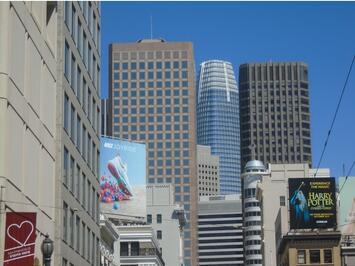
The city of San Francisco provides additional evidence illustrating the hollowing out of downtown areas from the pandemic and policy responses. The city did a remarkable job in keeping its death rate low, despite its density. Yet, the nature of COVID transmission, intensified in insufficiently ventilated crowded enclosed spaces, makes it virtually impossible for life to go on as normal in the hyperdense central business districts (the highest downtown employment density, for example, in Manhattan is more than four times the highest residential density), like downtown San Francisco. It also preclude retention of the uniquely high transit market shares on systems that feed the largest downtown areas, such as San Francisco’s BART regional metro, with its nearly 90% reduction in ridership through most of the COVID crisis.
San Francisco’s Municipal Railway (“Muni”), which is the principal transit provider within the core city of San Francisco (with less than 10 percent of the Bay Area’s population), is asking questions about service design in the wake of the pandemic. Muni operates the streetcar, bus, trolley bus and cable car services that cover the city of San Francisco.
San Francisco’s central business district is the fourth largest in the United States, with nearly 400,000 jobs (also less than 10% of Bay Area employment). But transit is very important here --- before the pandemic, more than 55% of downtown workers got there by transit. This compares to about 7% of reached by transit in the rest of the Bay area.
Yet, the “writing on the wall,” has occurred to Muni’s transit planners, who are asking whether the downtown focus of the transit system should be retained, as service levels are restored. The current system orientation, along with two others have been put before residents for comment. The choices are:
- The “Familiar Alternative,” which “would restore the all-day routes that haven’t been restored since the start of the pandemic. Muni officials said this scenario would allow riders to essentially return to their previous routes, would require “relatively little effort to implement,” and would acknowledge that some residents have chosen “where to live, or where to locate businesses, based on” the location of Muni lines.” Much of the service that was cancelled was on routes with low ridership.
- The “Frequent Alternative,” which “would boost service on high- ridership Muni lines and improve connections to grocery stores, hospitals, schools and workplaces. Wait times and crowding would be decreased.” Muni officials said that this scenario would maximize ridership and shift “resources from downtown trips to those connecting local neighborhoods.”
- The Hybrid Alternative,” which would seek to “balance the familiar and frequent alternatives by ‘truncating and extending routes and using the freed resources to increase frequencies’ on high-ridership Muni routes. This scenario would decrease wait times and crowding.”
These are difficult choices and from media reports, many transit agencies are barreling ahead simply assuming that the “old normal” will be restored. That the pre-World War I normal of commuting dominated by rail (subways, streetcars and interurbans) and walking has never even begun to be restored, despite the hundreds of billions (maybe even trillions) in spending should give pause.
My vote on Muni’s question is the same as I tried to formulate as policy while on the Los Angeles County Transportation Commission four decades ago --- maximizing ridership. Then, I was disappointed to learn that there was little support for reallocating poorly used services (mainly in the suburbs, where I lived) to the parts of the county where people were being left at bus stops because buses were too full. Urban cores, transit as well as the riders and taxpayers, would well served by maximizing ridership. Meanwhile, Muni, thank you for asking.
Wendell Cox is principal of Demographia, an international public policy firm located in the St. Louis metropolitan area. He is a founding senior fellow at the Urban Reform Institute, Houston, a Senior Fellow with the Frontier Centre for Public Policy in Winnipeg and a member of the Advisory Board of the Center for Demographics and Policy at Chapman University in Orange, California. He has served as a visiting professor at the Conservatoire National des Arts et Metiers in Paris. His principal interests are economics, poverty alleviation, demographics, urban policy and transport. He is co-author of the annual Demographia International Housing Affordability Survey and author of Demographia World Urban Areas.
Mayor Tom Bradley appointed him to three terms on the Los Angeles County Transportation Commission (1977-1985) and Speaker of the House Newt Gingrich appointed him to the Amtrak Reform Council, to complete the unexpired term of New Jersey Governor Christine Todd Whitman (1999-2002). He is author of War on the Dream: How Anti-Sprawl Policy Threatens the Quality of Life and Toward More Prosperous Cities: A Framing Essay on Urban Areas, Transport, Planning and the Dimensions of Sustainability.
Photograph: Downtown San Francisco: Former Crocker Bank headquarters, Sales Force Tower and former McKesson headquarters from Union Square, left to right (by author)













Familiar irony
Democratically determined systems, like Muni, will be less able to adjust to popular patterns than a private operator. Legacy interests will carry the day, at least until a municipal bankruptcy forces restructuring. (But Nancy Pelosi will surely delay that day.)